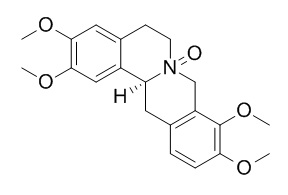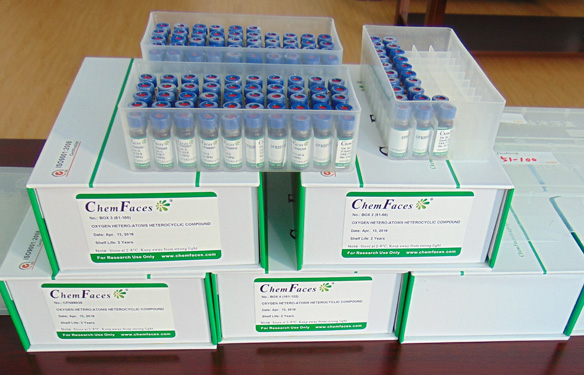Corynoxidine
Corynoxidine exhibits antibacterial activities against Staphylococcus aureus and methicillin-resistant S. aureus strains. It inhibits acetylcholinesterase activity in a dose-dependent manner, and the IC50 value of 89.0 microM.
Inquire / Order:
manager@chemfaces.com
Technical Inquiries:
service@chemfaces.com
Tel:
+86-27-84237783
Fax:
+86-27-84254680
Address:
1 Building, No. 83, CheCheng Rd., Wuhan Economic and Technological Development Zone, Wuhan, Hubei 430056, PRC
Providing storage is as stated on the product vial and the vial is kept tightly sealed, the product can be stored for up to
24 months(2-8C).
Wherever possible, you should prepare and use solutions on the same day. However, if you need to make up stock solutions in advance, we recommend that you store the solution as aliquots in tightly sealed vials at -20C. Generally, these will be useable for up to two weeks. Before use, and prior to opening the vial we recommend that you allow your product to equilibrate to room temperature for at least 1 hour.
Need more advice on solubility, usage and handling? Please email to: service@chemfaces.com
The packaging of the product may have turned upside down during transportation, resulting in the natural compounds adhering to the neck or cap of the vial. take the vial out of its packaging and gently shake to let the compounds fall to the bottom of the vial. for liquid products, centrifuge at 200-500 RPM to gather the liquid at the bottom of the vial. try to avoid loss or contamination during handling.
The Japan Society for Analy. Chem.2017, 66(8):613-617
Appl. Sci.2020, 10(8),2804
Pharmaceuticals (Basel).2024, 17(4):462.
Anticancer Res.2021, 41(3):1357-1364.
Advances in Traditional Medicine 2021, 21:779-789.
Molecules.2022, 27(19):6651.
Drug Des Devel Ther.2020, 14:5189-5204.
Hortic Res.2023, 10(4):uhad039.
Molecules.2017, 22(6)
Antioxidants (Basel).2023, 12(7):1324.
Related and Featured Products
J Asian Nat Prod Res. 2013;15(3):315-8.
A new antibacterial denitroaristolochic acid from the tubers of Stephania succifera.[Pubmed:
23418880 ]
METHODS AND RESULTS:
A new denitroaristolochic acid, demethylaristofolin C (1), together with six known alkaloids, crebanine N-oxide (2), (-)-sukhodianine-β-N-oxide (3), palmatine (4), corydalmine (5), dehydrocorydalmine (6), and Corynoxidine (7), was isolated from the tubers of Stephania succifera. The structure of demethylaristofolin C was elucidated by spectroscopic techniques (UV, IR, 1D, and 2D NMR) and HR-ESI-MS analyses.
CONCLUSIONS:
These compounds exhibited antibacterial activities against Staphylococcus aureus and methicillin-resistant S. aureus strains in different degrees.
Arch Pharm Res. 2004 Nov;27(11):1127-31.
Acetylcholinesterase inhibitors from the aerial parts of Corydalis speciosa.[Pubmed:
15595415]
METHODS AND RESULTS:
In a bioassay-guided search for acetylcholinesterase inhibitors from Korean natural resources, four isoquinoline alkaloids, Corynoxidine (1), protopine (2), palmatine (3), and berberine (4) have been isolated from the methanolic extract of the aerial parts of Corydalis speciosa. Structures of these compounds were elucidated on the basis of spectroscopic techniques.
CONCLUSIONS:
These compounds inhibited acetylcholinesterase activity in a dose-dependent manner, and the IC50 values of compounds 1-4 were 89.0, 16.1, 5.8, and 3.3 microM, respectively.



